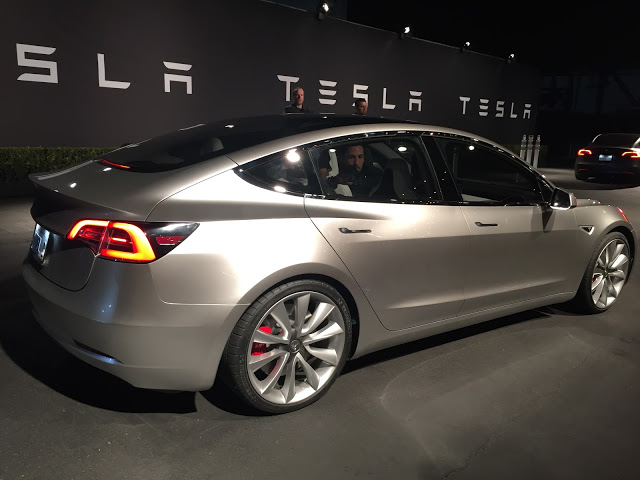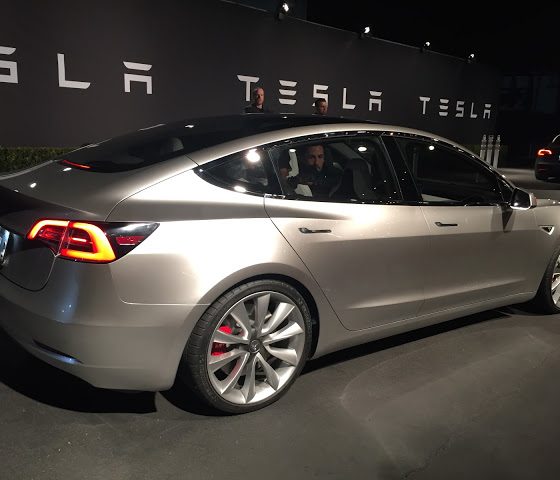

Energy
Tesla Model 3 battery options to top out at 75 kWh with likely 300+ mi. range
Tesla CEO Elon Musk has revealed that Model 3 battery options will max out at 75 kWh due to the vehicle’s shorter wheelbase, relative to the larger Model S and Model X which can accommodate up to a 100 kWh battery pack size.
The highly anticipated mass market electric car will be using Tesla’s newest high performance ‘2170 cell’ that’s currently being produced at Gigafactory 1 in Sparks, Nevada, and being used in Tesla’s Powerpack and Powerwall energy storage systems. Beyond having a larger form factor than the existing 18650 battery cell being used in Tesla’s existing vehicle fleet, the 2170 lithium-ion cell that boasts a higher energy density by as much as 30%.
ALSO SEE: Tesla Gigafactory 1 is beginning to look like a small city [Mar. 2017 photos]
Though Tesla has not specified the maximum driving range for Model 3, one can expect that a “Model 3 75D” would have a range higher than the heavier and larger Model S with 75 kWh pack. Looking at the Model S 60 which is capable of 210 miles of range, or .285 kWh/mile, one can assume that a smaller and lighter Model 3 would consume roughly .242 kWh/mile. Based on that estimate, a rear wheel drive Model 3 with 75 kWh battery pack will top out at 310 miles of range per charge. By comparison, the Chevy Bolt has a 60 kWh battery pack and is capable of achieving 240 miles of driving range, or .250 kWh/mile.
The shorter wheelbase only allows for a 75 kWh pack in Model 3 at current cell/module energy densities
— Elon Musk (@elonmusk) March 24, 2017
Model 3 to lead Chevy bolt with more range
It’s worth noting that the Chevy Bolt has a much higher drag coefficient than the Tesla Model S, which shares a similar aerodynamic design as the Model 3. The Bolt’s drag coefficient is .32 while the Model S has a drag coefficient of .24.
The lead designer of the Chevy Bolt, Stuart Norris, claims, “It’s a disaster for aero(dynamics)”, according to Digital Trends. The Model 3 on the other hand, has a very fluid design and will undoubtedly out-class the Chevy Bolt in aerodynamics and range. The more efficient Model 3 will allow the vehicle to have less battery for the same range.
Oh so little faith
— Elon Musk (@elonmusk) March 24, 2017
Musk later stated that the Model 3 would offer more range than the Chevy Bolt, which we are not surprised by. Musk also claims that cars like the Chevy Bolt are sold at a loss and help the manufacturer comply with emission requirements. While Tesla does generate revenue from emissions credits, they aren’t considered to be stable sources of income.
“What you will see our competitors do is they will limit their production, and they will only sell in ZEV states or almost entirely in ZEV states. That doesn’t scale. That will take them to maybe 40,000 units or 50,000 units a year, best case, but we’re talking about doing 500,000 units a year.” – Elon Musk Q3 Earnings Call
Musk tweeted a video showing a Model 3 release candidate driving down a local street today. The company says it’s on track to begin production of Model 3 in July. Tesla is expected to throw a Model 3 ‘Part 3’ launch event sometime in June ahead of planned production.

Cybertruck
Tesla updates Cybertruck owners about key Powershare feature

Tesla is updating Cybertruck owners on its timeline of a massive feature that has yet to ship: Powershare with Powerwall.
Powershare is a bidirectional charging feature exclusive to Cybertruck, which allows the vehicle’s battery to act as a portable power source for homes, appliances, tools, other EVs, and more. It was announced in late 2023 as part of Tesla’s push into vehicle-to-everything energy sharing, and acting as a giant portable charger is the main advantage, as it can provide backup power during outages.
Cybertruck’s Powershare system supports both vehicle-to-load (V2L) and vehicle-to-home (V2H), making it flexible and well-rounded for a variety of applications.
However, even though the feature was promised with Cybertruck, it has yet to be shipped to vehicles. Tesla communicated with owners through email recently regarding Powershare with Powerwall, which essentially has the pickup act as an extended battery.
Powerwall discharge would be prioritized before tapping into the truck’s larger pack.
However, Tesla is still working on getting the feature out to owners, an email said:
“We’re writing to let you know that the Powershare with Powerwall feature is still in development and is now scheduled for release in mid-2026.
This new release date gives us additional time to design and test this feature, ensuring its ability to communicate and optimize energy sharing between your vehicle and many configurations and generations of Powerwall. We are also using this time to develop additional Powershare features that will help us continue to accelerate the world’s transition to sustainable energy.”
Owners have expressed some real disappointment in Tesla’s continuous delays in releasing the feature, as it was expected to be released by late 2024, but now has been pushed back several times to mid-2026, according to the email.
Foundation Series Cybertruck buyers paid extra, expecting the feature to be rolled out with their vehicle upon pickup.
Cybertruck’s Lead Engineer, Wes Morrill, even commented on the holdup:
As a Cybertruck owner who also has Powerwall, I empathize with the disappointed comments.
To their credit, the team has delivered powershare functionality to Cybertruck customers who otherwise have no backup with development of the powershare gateway. As well as those with solar…
— Wes (@wmorrill3) December 12, 2025
He said that “it turned out to be much harder than anticipated to make powershare work seamlessly with existing Powerwalls through existing wall connectors. Two grid-forming devices need to negotiate who will form and who will follow, depending on the state of charge of each, and they need to do this without a network and through multiple generations of hardware, and test and validate this process through rigorous certifications to ensure grid safety.”
It’s nice to see the transparency, but it is justified for some Cybertruck owners to feel like they’ve been bait-and-switched.
Energy
Tesla starts hiring efforts for Texas Megafactory
Tesla’s Brookshire site is expected to produce 10,000 Megapacks annually, equal to 40 gigawatt hours of energy storage.

Tesla has officially begun hiring for its new $200 million Megafactory in Brookshire, Texas, a manufacturing hub expected to employ 1,500 people by 2028. The facility, which will build Tesla’s grid-scale Megapack batteries, is part of the company’s growing energy storage footprint.
Tesla’s hiring efforts for the Texas Megafactory are hinted at by the job openings currently active on the company’s Careers website.
Tesla’s Texas Megafactory
Tesla’s Brookshire site is expected to produce 10,000 Megapacks annually, equal to 40 gigawatt hours of energy storage, similar to the Lathrop Megafactory in California. Tesla’s Careers website currently lists over 30 job openings for the site, from engineers, welders, and project managers. Each of the openings is listed for Brookshire, Texas.
The company has leased two buildings in Empire West Business Park, with over $194 million in combined property and equipment investment. Tesla’s agreement with Waller County includes a 60% property tax abatement, contingent on meeting employment benchmarks: 375 jobs by 2026, 750 by 2027, and 1,500 by 2028, as noted in a report from the Houston Business Journal. Tesla is required to employ at least 1,500 workers in the facility through the rest of the 10-year abatement period.
Tesla’s clean energy boom
City officials have stated that Tesla’s arrival marks a turning point for the Texas city, as it highlights a shift from logistics to advanced clean energy manufacturing. Ramiro Bautista from Brookshire’s economic development office, highlighted this in a comment to the Journal.
“(Tesla) has great-paying jobs. Not just that, but the advanced manufacturing (and) clean energy is coming to the area,” he said. “So it’s not just your normal logistics manufacturing. This is advanced manufacturing coming to this area, and this brings a different type of job and investment into the local economy.”
Energy
Tesla and Samsung SDI in talks over new US battery storage deal: report
The update was related by industry sources and initially reported by South Korean news outlets.

Recent reports have suggested that Tesla and Samsung SDI are in talks over a potential partnership to supply batteries for large-scale energy storage systems (ESS).
The update was related by industry sources and initially reported by South Korean news outlets.
ESS batteries to be built at Samsung’s Indiana plant
As noted in a report from Korea JoongAng Daily, the demand for energy storage systems has been growing rapidly in North America, thanks in no small part to the surge in AI investments across numerous companies. With this in mind, Tesla has reportedly approached Samsung SDI about a potential battery supply deal.
The deal is reportedly worth over 3 trillion Korean won (approximately $2.11 billion) and will span three years, according to The Korea Global Economic Daily. A battery supply deal with Samsung SDI could make sense for Tesla as the company already has a grid-scale battery, the Megapack, which is perfect for industrial use. Samsung SDI could simply supply cells for the EV maker.
Production of the batteries would reportedly take place at Samsung SDI’s joint venture factory with Stellantis in Indiana, which is currently under construction. Samsung SDI recently announced plans to use part of that plant’s EV lines to produce cells for ESS, with a targeted capacity of 30 GWh by the end of next year.
Tesla and Samsung’s partnership
At present, only a handful of manufacturers, including Korea’s LG Energy Solution, Samsung SDI, SK On, and Japan’s Panasonic, are capable of producing energy storage-scale batteries domestically in the United States. A Samsung SDI official issued a comment about the matter, stating, “Nothing has been finalized regarding cooperation with Tesla.”
The possible energy storage system deal adds another layer to Tesla’s growing collaboration with Samsung, which is already in line as a partner in the upcoming production of Tesla’s AI5 and AI6 chips. Early sample manufacturing of the AI6 is expected to begin in South Korea, with mass production slated for Samsung’s Texas-based Taylor foundry when it starts operations.
The AI6 chip will power Tesla’s next wave of high-volume projects, including the Optimus humanoid robot and the autonomous Cybercab service. Musk has called the partnership with Samsung a “real collaboration,” adding that he personally plans to “walk the line” at the Taylor facility to speed up progress.








